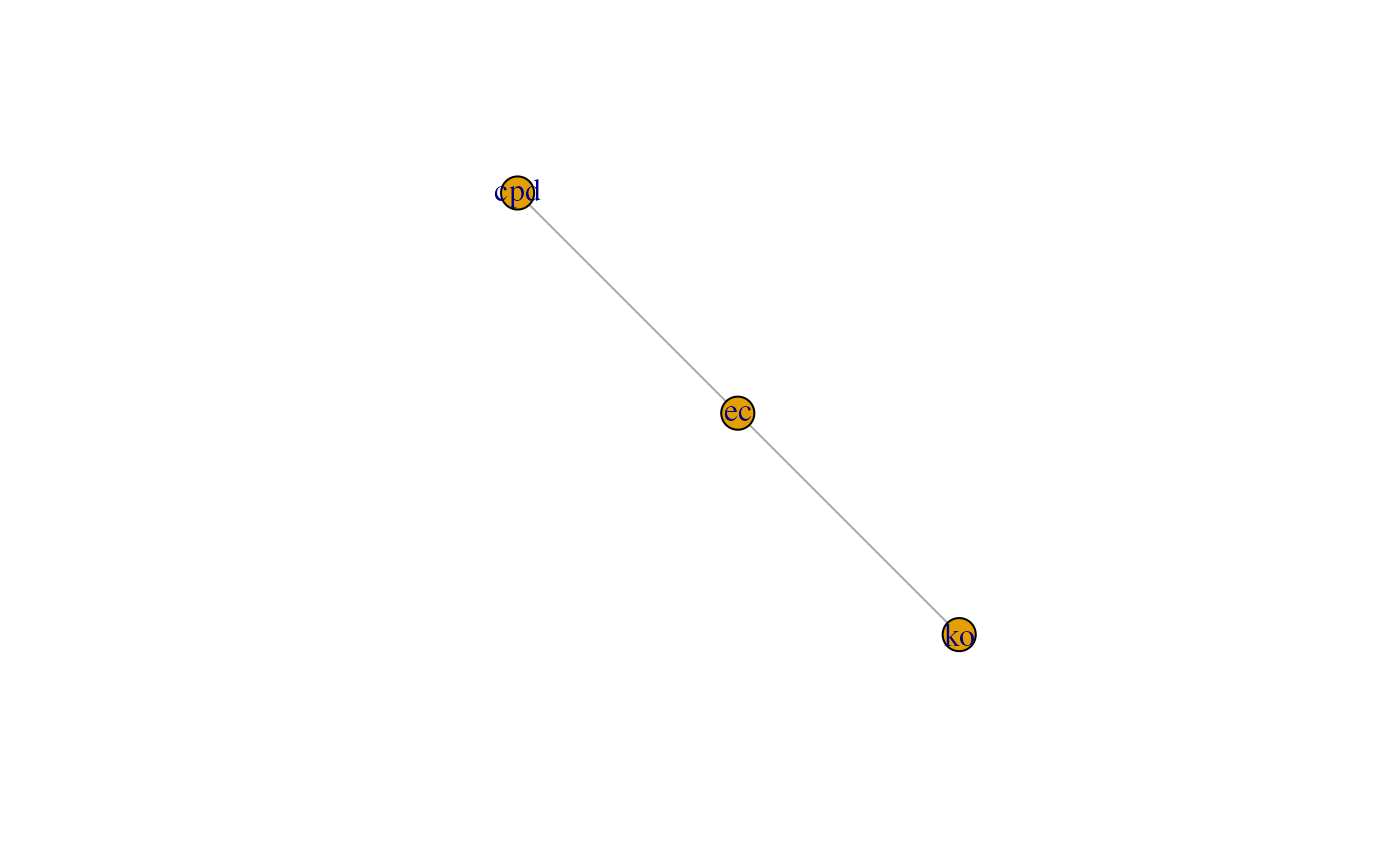Methods for MultiFactor S7 container class
Source:R/MultiFactor-methods.R, R/methods-getGraph.R
MultiFactor-methods.Rddroplevels()droplevels(MultiFactor)returns aMultiFactorwith unused levels removed, Analogous to thefactormethod.
Arguments
- ...
i,jindices specifying elements to extract or replace. Indices are numeric or character vectors or empty (missing) or NULL. Numeric values are coerced to integer or whole numbers as by as.integer or for large values by trunc (and hence truncated towards zero). Character vectors will be matched to the names of the object.- value
Replacement value, typically of same type as that which is to be replaced.
- exclude
NULLorNamed character listof similar structure aslevels(MultiFactor). Which levels to drop from output.- select
NULLorNamed character listof similar structure aslevels(MultiFactor). Which levels to keep in output.- use.names, ignore.mcols
For compatibility, not used.
- x
MultiFactor- format
Character scalar, controls output format by package name."igraph"and"graph"are supported.
See also
igraph::graph_from_data_frame() and
igraph::as_graphnel(), which are used under the hood, from
igraph::igraph() package.
Examples
# Setup
x <- MultiFactor(kegg_link())
x
#> An anansi::MultiFactor S7_object,
#> 3 feature types across 2 edge lists.
#>
#> ec ko cpd
#> ec2ko 5581 8817 .
#> ec2cpd 5934 . 7802
#>
#> Values represent unique feature names in that edge list.
#>
#> Levels:
#>
#> ec : 6690 Levels: 1.1.1.1 1.1.1.2 ... 5.3.1.37
#> ko : 8817 Levels: K00001 K00002 ... K28089
#> cpd : 7802 Levels: C00001 C00002 ... C23000
# Basic properties
dim(x)
#> [1] 2 3
dimnames(x)
#> [[1]]
#> [1] "ec2ko" "ec2cpd"
#>
#> [[2]]
#> [1] "ec" "ko" "cpd"
#>
# Factor-like properties
head(levels(x)$ko)
#> [1] "K00001" "K00002" "K00003" "K00004" "K00005" "K00006"
droplevels(x)
#> An anansi::MultiFactor S7_object,
#> 3 feature types across 2 edge lists.
#>
#> ec ko cpd
#> ec2ko 5581 8817 .
#> ec2cpd 5934 . 7802
#>
#> Values represent unique feature names in that edge list.
#>
#> Levels:
#>
#> ec : 6690 Levels: 1.1.1.1 1.1.1.2 ... 5.3.1.37
#> ko : 8817 Levels: K00001 K00002 ... K28089
#> cpd : 7802 Levels: C00001 C00002 ... C23000
head(unfactor(x)$ec2ko)
#> ec ko
#> 1 1.1.1.1 K00001
#> 2 1.1.1.2 K00002
#> 3 1.1.1.3 K00003
#> 4 1.1.1.4 K00004
#> 5 1.1.1.303 K00004
#> 6 1.1.1.6 K00005
# Extract common output formats
getEdgeList(x)
#> V1 V2
#> ec2ko ec ko
#> ec2cpd ec cpd
droplevels(x, exclude = list(ko = "K00001"))
#> An anansi::MultiFactor S7_object,
#> 3 feature types across 2 edge lists.
#>
#> ec ko cpd
#> ec2ko 5581 8816 .
#> ec2cpd 5934 . 7802
#>
#> Values represent unique feature names in that edge list.
#>
#> Levels:
#>
#> ec : 6690 Levels: 1.1.1.1 1.1.1.2 ... 5.3.1.37
#> ko : 8816 Levels: K00002 K00003 ... K28089
#> cpd : 7802 Levels: C00001 C00002 ... C23000
droplevels(x, select = list(ko = "K00001"))
#> An anansi::MultiFactor S7_object,
#> 3 feature types across 2 edge lists.
#>
#> ec ko cpd
#> ec2ko 1 1 .
#> ec2cpd 5934 . 7802
#>
#> Values represent unique feature names in that edge list.
#>
#> Levels:
#>
#> ec : 5934 Levels: 1.1.1.1 1.1.1.2 ... 5.3.1.37
#> ko : 1 Levels: K00001
#> cpd : 7802 Levels: C00001 C00002 ... C23000
# Generate an igraph object
g <- getGraph(x = kegg_link(), format = "igraph")
plot(g)
